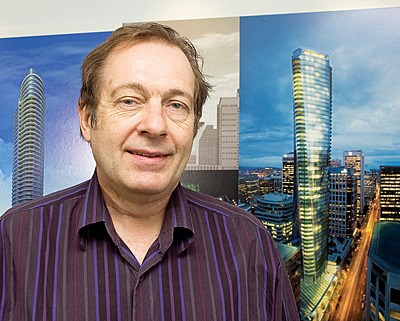From the newly announced Telus Gardens to the seven mega-tower sites recently approved in the downtown core, one thing seems certain: Vancouverites can expect to look up, way up, to see the future of development in the city.
Tall towers may be an icon of urban development, but for many in Vancouver, up is not a comfortable direction particularly as the issue of increased building heights extends to traditionally mid-rise areas. Case in point: Chinatown, where those in favour of building towers are preparing for a showdown against concerned community groups at the Chinatown Height Review public hearing scheduled to take place tonight at city hall.
Most of Chinatowns population now has spread to Richmond, to Coquitlam, to wherever, and the vital aspects of the businesses and the feeling of Chinatown has been lost over the years and they need to bring population in, says Ron Yuen, principal architect with dys architecture, which is involved in one of the proposals for the area that could see building heights of up to 150 feet.
For those in the business of building towers, Yuen says going up is the most efficient way to ensure affordable housing and sustainable development downtown where land is at a premium. The challenge for the city as thousands more arrive here each year is to continue to use height to maximize space and light in underutilized pockets of the downtown core. Fortunately, says Yuen, Â鶹´«Ã½Ó³»has a strong tradition of creating successful vertical communities.
Weve had some great planners in the city who have said: OK, heres how were going to make it livable. Were going to bring people to the downtown core who are going to build a Concord Pacific, where we can live, work and play. And were going bring that density to the core. And its made it very livable. Were very fortunate that way.
Height may not be appropriate for all areas of the downtown, says Yuen, adding he understands the reticence of community groups, academics and citizens who unleashed a torrent of opposition in January in response to a city staff recommendation to increase building heights in the Downtown Eastside.
Fears that increased height and density would lead to gentrification and wreak havoc on the areas vulnerable population forced the issue to be put on hold. But in Chinatown and perimeter areas of the downtown core, proponents argue its precisely well-planned use of height that will preserve integrity and affordability.
Chinatown resident and former NPA city council candidate Sean Bickerton says he welcomes towers to the neighbourhood, including a proposal for a residential tower on what is now an empty lot on the corner of Pender and Abbott. Were much better off with a tower there, with neighbours, with people on the street... than with people using our community as a toilet and a shooting gallery, he told WE. So within that context, not only is a tower desirable, it is necessary to eliminate the chaos and the filth in our neighbourhood.
Much of Vancouvers fear of heights likely has more to do with the way city council has implemented spot rezonings across the city rather than establishing a comprehensive plan for height and density, Bickerton adds. I think its important off the bat to understand what people are actually concerned about. Theyre concerned about change and rapid change and losing the quality of life that they enjoy. I think those are legitimate concerns from people that are worried about tall towers. Bickerton says hes pushing for an overarching city plan to deal with height and density along transit hubs and arterial routes.
However Dane Jansen, also of dys architecture, says the city did some things right when it started experimenting with tower developments in the 1960s and 70s. Jansen says when tall towers first came to residential neighbourhoods like the West End, city planners hit a sweet spot by mandating a magic distance of 80 feet between towers, a policy which lingers today and, in Janzens opinion, has made the most of limited resources such as open space and sunlight in the downtown core.
Part of our vocabulary around towers in the City of Â鶹´«Ã½Ó³»is, quite often, we as architects back our way into things. Things just happen as they evolve and what you have is this amazing experience in the West End with high density and yet the sense of livability and the sense of community, he says.
The perplexing thing about the current backlash against towers, adds Janzen, is that much of it is centered in the West End, where 11,000 people have signed a petition to stop spot rezonings in the neighbourhood, largely pertaining to tower developments. Its an interesting thing because theyre living in towers, Janzen notes. Its getting to the point where people obviously want to protect what we have and yet we still need to have economic growth, we have a regional growth strategy, we have a sustainability strategy that says we need to continue to see some 25,000 people flood into Metro Â鶹´«Ã½Ó³»on an annual basis, if not more.
Of course, the architects have a vested interest in pushing for increased heights, which will allow them to leave their architectural mark on the city. Both Janzen and Yuen are particularly excited about their newest project the 616-foot so-called Twisty Tower conceived in part with the late Arthur Erickson. Theyd like to see the building become a defining part of Vancouvers skyline when it is erected at 1151 West Georgia. Wed be hypocritical if we didnt say go higher, because we actually wanted our building to be higher, admits Janzen. It just seemed to us that you make the statement stronger the higher that you go.



